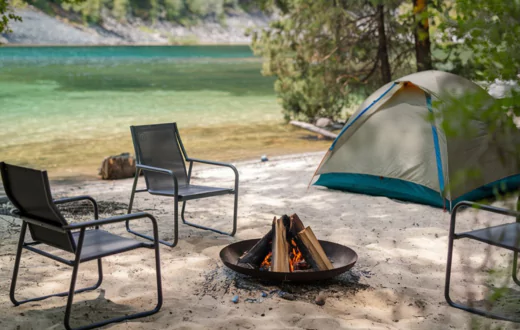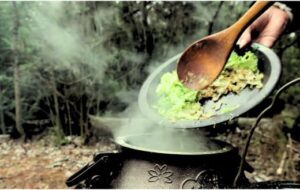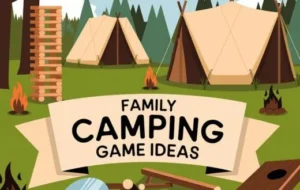This is a complete guide to camping for beginners.
In this beginner camping guide, you will go through everything about:
- How beginners can start camping
- Knowing the different types of camping
- Picking the right gear
- Choosing and planning the perfect destination and campsite
- Breaking down outdoor meal planning ideas
Overcoming common camping challenges And much more!
So, if you want to grow your camping experience, follow these ultimate beginner camping tips as well as it will be my best camping advice for beginners.
Let’s get started!
What is Camping?
Camping is an outdoor activity where people stay overnight in a tent. It allows them to enjoy nature and engage in activities like hiking, fishing, and cooking over a campfire.
Why is it good to go to Camping?
Camping is a great way to take a break from daily life, enjoy nature, and refresh both your body and mind.
In today’s busy world, we spend too much time on screens and get stuck in routines that can feel overwhelming.
Stepping outside and spending time in nature helps us relax and feel less stressed.
The fresh air, quiet surroundings, and simple way of living make us feel calm and happy.
One of the best things about camping is how it brings people closer together.
Whether you go with family, friends, or even alone, it helps create strong connections.
Without phones and social media, we can have real conversations, share stories, and enjoy each other’s company.
Families especially benefit, as camping gives them time to bond over campfires, outdoor games, and shared adventures.
Camping is also great for your health.
Activities like hiking, setting up tents, and collecting firewood give your body a good workout.
Fresh air and sunlight help you sleep better, improve your mood, and boost your overall well-being.
Plus, being in nature has been proven to reduce anxiety and make people feel happier.
Some people worry about camping challenges, like bugs, bad weather, or not having modern comforts.
But with the right preparation, these things can be part of the fun camping for beginners.
Bringing the right gear, choosing a good campsite, and planning meals ahead can make camping easy and enjoyable—even for beginners.
If you need a break from city life, want to spend more time with loved ones, or just enjoy the outdoors, camping is a perfect choice.
It’s a simple yet powerful way to refresh your mind, body, and soul while taking in nature’s beauty.
How to Start Camping for the First Time?
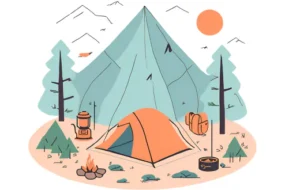
Camping for beginners can feel overwhelming, but with the right preparation, it can be an enjoyable and stress-free experience.
Start by choosing a beginner-friendly campground with basic facilities like bathrooms and picnic tables.
National parks and established campgrounds are great options. Make a camping checklist with essentials like a tent, sleeping bag, and cooking gear.
A two-person tent is ideal for solo campers or couples. Pack layers of clothing to stay warm and bring rain gear in case of unexpected weather.
For food, keep it simple, plan easy camping meals and store perishables in a cooler with ice packs.
A camp stove makes cooking convenient, while a reusable water container ensures you have enough drinking water.
Check the weather forecast before leaving and arrive with plenty of time to set up before dark.
Don’t forget camping safety tips carry a first-aid kit, bug spray, and a flashlight.
Respect nature by following Leave No Trace principles and keeping the campsite clean.
If you’re new to the outdoors, car camping is a great way to ease into the experience.
With proper planning and the right camping gear for beginners, your first trip will be comfortable, fun, and memorable.
Let’s know everything about how to go camping for beginners.
Let’s get started from here! How to Start Camping? First of all!
Choosing the Right Type of Camping for Beginners

Choosing the right type of camping is essential for a comfortable and enjoyable experience.
As a beginner, understanding different camping styles will help you find the best fit based on your comfort level, gear, and expectations. Below are various types of camping, each offering unique experiences.
Tent Camping
Tent camping is the most common and budget-friendly option for beginner campers.
It requires a tent, sleeping bag, and essential camping gear. Campgrounds with picnic tables, fire pits, and bathrooms are ideal for a first-time camping trip.
Always check the weather forecast and pack appropriate clothing, such as base layers for cold weather and rain gear for unexpected conditions.
Wild Camping
For those seeking adventure, wild camping means setting up camp in remote locations without designated facilities.
It requires self-sufficiency, including a reliable water source, camping stove, and extra food. Always follow Leave No Trace principles and check park service regulations before heading out.
Car Camping
Car camping is a great option for camping for beginners who want convenience.
You can pack all your camping gear in your vehicle and set up camp at a designated campground.
This type of camping allows you to bring more supplies, such as a camp stove, cooler for keeping food cold, and a comfortable sleeping setup.
RV Camping
RV camping provides the comfort of a home on wheels, making it an excellent choice for families or those who prefer modern amenities.
Most campgrounds offer RV hookups, bathrooms, and picnic tables. A campground reservation is recommended, especially in national parks and popular campgrounds.
Backpacking
Backpacking is a more challenging type of camping that involves hiking to a remote location with all your gear in a hiking backpack.
It requires careful planning, lightweight gear, and knowledge of safety tips like keeping food away from pests.
Backpackers should carry a camp stove, plenty of drinking water, and compact camping gear.
Glamping
Glamping combines camping with luxury, offering pre-set accommodations like cabins, yurts, or safari tents.
It’s ideal for those who want the outdoor experience without roughing it. Many glamping sites provide comfortable bedding, electricity, and even gourmet meals.
Hammock Camping
Hammock camping is a lightweight and space-saving alternative to tent camping.
It’s perfect for warmer weather conditions but requires sturdy trees and proper insulation for cold nights.
A rain fly and bug net can make hammock camping more comfortable.
Solo Camping
Solo camping allows for a peaceful and self-reflective outdoor experience.
Beginner campers should start with a well-established campground for safety.
Bringing a detailed grocery list, extra food, and safety gear like a flashlight and first-aid kit is essential camping for beginners.
Group Camping
Camping with friends or fellow campers creates a social and fun experience.
Group camping requires coordination, from planning meals to ensuring there’s plenty of space for everyone.
Sharing camp kitchen gear and duties, such as washing dishes and setting up tents, makes the trip more manageable.
Family Camping
Family camping is great for bonding and introducing kids to nature.
Choose campgrounds with bathrooms, picnic tables, and family-friendly activities.
Packing plenty of snacks, a camp stove for quick meals, and entertainment for kids can make the trip smoother.
Seasonal Camping
Camping during different seasons requires specific preparations.
Cold weather camping demands insulated sleeping bags, layers for body heat retention, and a camping stove suitable for low temperatures.
Hot weather camping calls for breathable clothing, a reusable water container, and shade for sun protection.
No matter which camping style you choose, proper preparation ensures a smooth and enjoyable experience for camping for beginners.
Now that you know the types of camping, let’s know about the Essential Camping Gear for Beginners to help you get started with the right equipment.
Essential Camping Gear for Beginners
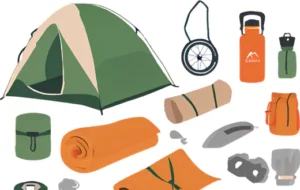
Planning your first camping trip?
Exciting! But without the right gear and camping essentials for beginners, what should be a fun adventure can quickly turn into a challenge.
Whether you’re heading to national parks or setting up at a campground with picnic tables, packing the right equipment will make your trip smoother, safer, and more enjoyable.
Here’s a simple guide to essential camping gear for beginners.
Shelter & Sleeping Gear
Tent
A reliable tent is the foundation of a good camping experience.
A 2-person tent is perfect for beginner campers. It’s easy to set up and provides enough space for sleeping and gear storage.
Look for one with a rain fly for wet conditions and proper ventilation to prevent condensation.
If you’re camping in cold weather, a well-insulated tent will help retain body heat and keep you warm through the night.
Sleeping Bags & Sleeping Pads
A good sleeping bag is key to staying warm and comfortable. Choose one suited for the weather conditions you’ll be camping in.
If it gets chilly, opt for a sleeping bag with a Merino wool layer for extra warmth.
Pair it with an inflatable sleeping pad for cushioning and insulation.
A compact camping pillow can also improve your sleep quality.
Cooking Equipment
Camp Stove & Cooking Gear
A camping stove is essential for preparing meals efficiently.
A propane camp stove is great for beginners as it’s easy to use and reliable.
Don’t forget a camp kitchen gear set, including camp dishware, utensils, and a pot or pan.
Bring biodegradable dish soap to wash dishes properly and minimize environmental impact.
Food Storage & Water
Keep food fresh in a hard-sided cooler to prevent spoilage.
If you’re camping in areas with wildlife, use campsite food storage lockers to keep food safe from pests.
Pack enough drinking water in a reusable water container or 5-gallon water jugs.
If you’re camping in remote locations, bring a water filter or purification tablets to make water safe for drinking.
Clothing & Footwear
Dress for the Weather Layering is key for comfort.
Wear base layers to wick moisture in hot weather and insulate in cold weather.
A rain jacket or rain gear is a must for unexpected showers.
Pack extra clothing based on the weather forecast and bring hiking essentials like a hiking backpack and sturdy hiking boots.
Safety & First Aid
First Aid Kit & Emergency Items
A first aid kit is a must-have. It should include bandages, antiseptic wipes, and supplies for treating common hiking wounds.
A multi-tool is handy for quick fixes, and a headlamp provides visibility at night.
Always check the weather conditions before heading out to stay prepared for any changes.
Bug Spray & Sun Protection
Protect yourself from invasive insects by using bug spray with DEET or a natural alternative.
Apply sunscreen and wear sunglasses to guard against UV rays, especially in dry weather.
Other Essentials
- Navigation Tools: Download Google Maps and carry a compass in case you lose cell service.
- Duct Tape: Useful for quick tent repairs or securing loose gear.
- Camping Hygiene: Pack biodegradable soap, toilet paper, and hand sanitizer for cleanliness.
- Campground Etiquette: Follow quiet hours and respect fellow campers by keeping noise levels down.
Having the right camping gear for beginners ensures a smooth and enjoyable trip.
Now that you’re prepared with the essentials, it’s time to choose the perfect spot for your next adventure.
Whether you’re drawn to tent camping in national parks or a more relaxed car camping experience, picking the right destination is key.
Camping Destinations & Planning for Beginners
Camping is a great way to reconnect with nature, but if you’re a beginner, planning your first trip can be overwhelming.
Choosing the right destination, understanding the different types of camping, and knowing what to pack are all essential for a successful experience with these simple camping tips for beginners.
Let’s break it down step by step so you can confidently plan your first camping trip.
How to Choose the Perfect Campsite
Picking the right campsite is key to having a fun and stress-free adventure. Here’s what to consider:
- Location: Do you prefer camping in a national park, a campground with bathrooms, or primitive camping in the wild?
- Accessibility: Some campsites require a hike, while others allow car access. Choose one that fits your camping style and experience level.
- Amenities: If you want comfort, look for campsites with picnic tables, water supply, food storage lockers, and fire pits.
- Weather conditions: Check the weather forecast to prepare for cold weather, heat, or rain.
- Campsite rules: Research quiet hours, check-in times, and pet regulations before booking.
Campgrounds vs. Wild Camping
Campgrounds (Developed Campsites)
- Have facilities like restrooms, drinking water, and fire pits.
- Easy to access and family-friendly.
- Require reservations, often months in advance for popular spots like Yosemite National Park.
- Can be crowded with fellow campers nearby.
Wild Camping (Backcountry or Dispersed Camping)
- Offers solitude and a deeper nature experience.
- No reservations needed—first come, first served.
- Requires more preparation, including bringing your own gear, water source, and waste disposal system.
- No facilities—expect pit toilets, no trash bins, and no running water.
What to Look for in a Campsite
- Flat Ground : Look for an even surface to set up your tent.
- Water Source: Being close to a water source like a river or lake is helpful, but avoid flood-prone areas.
- Shade & Wind Protection: Trees offer shelter, but avoid camping under dead branches.
- Safety: Stay clear of cliffs, unstable terrain, and areas with many insects.
How to Reserve a Campsite
- Use Google Maps or the park service website to research campsites.
- Book through official sites like Recreation.gov or Reserve America.
- Popular campsites often require booking months in advance, especially during peak season.
- Confirm the price and available amenities before finalizing your reservation.
Key Factors to Consider for Your First Camping Trip
- Camping Style: Choose between tent camping, RV camping, or car camping.
- Essential Gear: Pack a camping stove, sleeping bag, hiking backpack, and compact pillow.
- Clothing Materials: Use Merino wool layers for warmth and pack a rain fly for light rain.
- Food & Cooking: Store food in hard-sided coolers and use a propane camp stove.
- Safety Tips : Arrive at least an hour before sunset to set up your campsite in daylight.
- Leave No Trace Principles: Always pack out trash, use biodegradable dish soap, and respect nature.
Understanding Leave No Trace Principles
Following Leave No Trace (LNT) principles helps preserve nature for future campers:
- Plan ahead & prepare : Research the conditions, create a grocery list, and pack a camping checklist.
- Dispose of waste properly : Carry out all trash and wash dishes at least 200 feet away from water sources.
- Respect wildlife : Store food properly in food storage lockers to avoid attracting animals.
- Be considerate of others : Follow quiet hours and keep noise to a minimum at night.
Planning your first camping trip is all about preparation and selecting the right destination.
Whether you choose a popular campground or opt for wild camping, knowing what to expect and having the proper gear will set you up for success.
Next Up: Meal Planning and Cooking Outdoors – Learn how to pack and prepare delicious meals while camping.
Meal Planning and Cooking Outdoors

If you’re planning your first camping trip, figuring out what to eat and how to cook can feel overwhelming.
Trust me, I’ve been there! But with a little preparation, meal planning and cooking outdoors can be easy, fun, and delicious.
Let’s go over the essentials, from simple camping meals to food storage and cooking methods.
Easy Camping Meal Ideas for Beginners
You don’t need to be a pro chef to enjoy great food in the wild.
Here are some beginner-friendly meal ideas that require minimal prep and cooking time:
- Breakfast: Instant oatmeal with dried fruits, scrambled eggs with tortillas, or camp coffee with granola bars.
- Lunch: Peanut butter and jelly sandwiches, wraps with deli meat and cheese, or canned tuna with crackers.
- Dinner: Foil packet meals (chicken and veggies), one-pot pasta, or chili cooked over a camp stove.
- Snacks: Trail mix, beef jerky, fresh fruit, and granola bars for quick energy.
When planning, think about food storage and cooking gear.
A good camping stove, cooler, and basic camp kitchen gear will make a huge difference in your cooking experience.
Food Storage & Safety (Bear Bags, Coolers, etc.)
Keeping your food fresh and safe is crucial. Here’s what you need to know:
- Coolers: Use a hard-sided cooler for perishable foods and keep it packed with ice or frozen gel packs. A soft-sided cooler is great for short trips.
- Bear Safety: If you’re in bear country, store food in bear-proof food lockers or use a bear bag hung at least 12 feet high and 6 feet away from the tree trunk.
- Preventing Spoilage: Keep your cold food cold by packing frozen items and using a reusable water container to keep things chilled longer.
- Dry Food Storage: Store non-perishables in airtight containers and keep them in your car or campground food lockers to avoid attracting wildlife.
Always follow Leave No Trace principles, pack out all trash, wash dishes with biodegradable dish soap, and never leave food scraps behind.
Cooking Over a Fire vs. Using a Camp Stove
Both methods have pros and cons, so choosing the right one depends on your camping style:
Campfire Cooking:
Ideal for grilling meats, roasting marshmallows, and making foil packet meals.
Requires dry firewood, good weather conditions, and knowledge of fire safety guidelines.
Takes more time and effort but adds a fun, rustic touch to your camping experience.
Camp Stove Cooking:
Reliable in all weather conditions (wind, rain, cold weather).
Easy to control temperature for precise cooking.
Requires a propane camp stove or fuel source.
For beginners, I recommend bringing a camp stove model for reliability and using a campfire for fun, when possible.
Meal Planning for Short vs. Long Trips
Planning meals differs depending on the length of your trip. Here’s how to approach it:
Short Camping Trips (1-3 Days)
You can pack fresh foods like eggs, milk, and meats without worrying too much about spoilage.
A small cooler or soft-sided cooler works fine.
Prep meals at home to save lots of time at the campsite.
Long Camping Trips (4+ Days)
Prioritize shelf-stable foods (dried pasta, rice, canned beans, and jerky).
Bring a hard-sided cooler with extra ice for perishable items.
Plan meals that use similar ingredients to minimize packing (e.g., tortillas for breakfast wraps and dinner tacos).
Consider using campground grocery stores if available for fresh supplies.
Camping meals don’t have to be complicated.
With a solid meal plan, proper camping gear, and a little preparation, you’ll enjoy delicious, stress-free meals in the great outdoors.
Whether you’re cooking over a fire or using a camp stove, always follow campground safety tips and respect nature.
Next up, we’ll cover Safety and Survival Basics: Camping for Beginners, including essential safety gear, survival skills, and staying warm in different weather conditions.
Safety and Survival Basics: Camping for beginners
So, you’re ready to take your first camping trip? That’s awesome!
Camping is one of the best ways to connect with nature, unwind, and experience a break from the daily hustle.
But, let’s be real, camping for beginners can feel a little overwhelming.
What gear do you need? How do you stay safe? What if the weather turns bad?
Don’t worry—I’ve got you covered with all the safety and survival basics you need to enjoy a stress-free trip.
Planning Your Camping Trip the Right Way
Before you even pack your bags, planning is key.
You don’t want to be scrambling at the last minute or, worse, find out that your campground of choice is fully booked. Here’s what to do:
- Choose the Right Campground : If you’re new to camping, go for a campground with bathrooms, picnic tables, and a water source. National parks are a great option.
- Make a Reservation : Popular campgrounds can fill up months in advance, so book early.
- Check the Weather Forecast: Whether it’s hot weather or cold weather, knowing what to expect helps you pack appropriately.
- Have a Camping Style in Mind : Tent camping, car camping, or even primitive camping—each type of camping requires different preparation.
Must-Have Camping Gear for Beginners
Packing the right camping gear makes all the difference in your experience. Here’s a basic checklist to help you begin:
- Shelter & Sleeping : A quality 2-person tent, a rain fly, an inflatable sleeping pad, and a compact camping pillow for a good night’s sleep.
- Clothing: Pack layers! A good base layer (Merino wool is great), rain gear for light rain, and extra clothing for weather changes.
- Cooking Gear : A propane camp stove, camp dishware, biodegradable dish soap, and a soft-sided or hard-sided cooler to keep your food cold.
- Food & Water : Bring extra food, a reusable water container, and know your water supply options (e.g., water fountains at campgrounds).
- Hiking Essentials: If you plan to explore, a hiking backpack with a hiking gear checklist, including a map (Google Maps can help), first-aid kit, and bug spray.
- Emergency & Safety: Duct tape (trust me, it fixes everything), a flashlight, a first-aid kit, and safety guidelines printed in case of an emergency.
Camping Safety Tips for New Campers
Even the most prepared beginner campers can face unexpected challenges. Here’s how to stay safe:
- Fire Safety: Keep campfires at least inches deep in a fire pit, never leave them unattended, and fully extinguish them before sleeping.
- Wildlife Awareness: Store food in campsite food storage lockers or cars to keep food from pests and bears.
- Water Safety: Always bring or filter drinking water; never rely solely on natural water sources.
- Nighttime Precautions: Keep a flashlight handy, follow quiet hours, and be aware of your surroundings.
- Hygiene & Waste Management: Use biodegradable dish soap, wash dishes properly, and pack toilet paper in case pit toilets run out.
How to Stay Warm While Camping
Camping in cold weather? Here’s how to retain body heat and sleep comfortably:
Use quality base layers (Merino wool works wonders).
Wear dry socks before getting into your sleeping bag.
Keep a soft-sided cooler inside your tent for insulation.
Choose an inflatable sleeping pad for added warmth.
Stay dry—wet clothes drain body heat quickly.
Common First-Time Camping Mistakes to Avoid
- Not Packing Enough Water: Always carry home-buy 5-gallon water jugs or a reusable water container.
- Overpacking or Underpacking: Limited space means packing smart. Create a detailed grocery list and a shopping list for essentials.
- Ignoring Safety Guidelines: Always check-in with the park service and be aware of non-native insects and invasive insects in the area.
- Setting Up Camp Too Late: Arrive at least an hour before sunset to set up your tent with plenty of time to spare.
- Not Checking Gear Before the Trip: Test your camp stove model, flashlight, and tent setup at home first.
Now that you’ve got the safety and survival basics down, it’s time to focus on the fun side of camping.
From hiking to campfire cooking, there are so many exciting things to do.
Fun Camping Activities for Beginners to make your trip even more cheerful.
Fun Camping Activities for Beginners
So, you’re planning your first camping trip – exciting, right?
But now you’re wondering, “What are some fun camping activities for beginners?
Don’t worry! I’ve got you covered with the best beginner-friendly camping activities that will make your outdoor adventure truly memorable with the best camping guide for beginners.
1. Hiking & Exploring the Area
One of the best ways to soak in the beauty of nature is by going on a hike.
Whether you’re in a national park or a remote campground, hiking gives you plenty of time to connect with nature.
Here’s what you need to know:
- Gear Up Properly: A comfortable hiking backpack with essentials like a water bottle, bug spray, and hiking guides is a must.
- Follow Trails: Stick to marked trails and use Google Maps or a printable hiking gear checklist to navigate.
- Check the Weather: The right weather forecast ensures you dress appropriately in base layers or rain gear.
- Hiking Safety : Watch out for common hiking wounds like blisters. Carry a first-aid kit.
Pro Tip: Choose trails that match your fitness level and start early to have lots of time for breaks and photos.
2. Fishing, Swimming, and Other Water Activities
Camping near a water source? Take advantage of it!
Here are a few fun activities you can enjoy:
- Fishing: Bring a fishing rod, check local fishing regulations, and try your luck catching dinner.
- Swimming: Cool off in a lake or river, but always be aware of currents and safety rules.
- Kayaking or Canoeing: If your campground offers rentals, try paddling around for a peaceful nature experience.
- Skipping Rocks & Relaxing: Sometimes, simple activities like skipping rocks or dipping your feet in the water can be the most relaxing part of your trip.
Pro Tip: Always pack extra food and use a soft-sided cooler to keep camping meals fresh. Also, store food properly in campsite food storage lockers to prevent attracting wildlife.
3. Campfire Stories & Games
What’s a camping trip without a cozy campfire? Here are some fun ways to spend your evening:
- Classic Campfire Games: Play games like “Would You Rather?” or “20 Questions.”
- Tell Spooky Stories : Gather around and take turns telling ghost stories (but not too scary if you’re camping with kids!).
- Sing Songs or Play Music: Bring a small guitar or use a Bluetooth speaker (respecting quiet hours).
- Make S’mores: Grab marshmallows, chocolate, and graham crackers to create this classic camping treat!
Pro Tip: Use a camp stove model or campfire safety guidelines to cook safely. And don’t forget biodegradable dish soap to wash dishes afterward.
4. Stargazing & Nighttime Activities
One of the most magical parts of camping is the night sky.
If you’re in a popular campground far from city lights, you’re in for a breathtaking view.
- Stargazing Apps : Download an app to identify constellations and planets.
- Firefly Watching: If you’re camping in warm weather, enjoy the natural light show of fireflies.
- Night Hikes: With a headlamp and flashlight, explore trails and listen to nature at night.
- Photography: Try capturing the stars with your camera on a long exposure setting.
Pro Tip: Wear Merino wool layers for warmth and bring a compact camping pillow for a comfortable sleep under the stars.
Camping for beginners doesn’t have to be overwhelming.
By adding these fun activities to your trip, you’ll create lasting memories.
Just remember to pack smart, follow Leave No Trace principles, and embrace the adventure.
Before you go, make sure you’re prepared for any challenges that might come your way. Up next: Dealing with Common Camping Challenges.
Dealing with Common Camping Challenges
Camping is an amazing experience, but let’s be real, things don’t always go as planned.
From unpredictable weather conditions to pesky bugs and gear troubles, camping for beginners can come with challenges.
But don’t worry! With a little preparation, you can tackle any obstacle and have an unforgettable trip.
Let’s dive into some common camping challenges and how to handle them like a pro.
1. Bad Weather & How to Prepare
The weather can change fast, and beginner campers often underestimate how much it can impact a camping trip.
Whether it’s cold weather, light rain, or extreme heat, here’s how to stay comfortable:
- Check the Weather Forecast: Always look at the forecast before heading out and pack accordingly.
- Pack Rain Gear: A rain fly for your tent, a waterproof jacket, and Duct tape for quick fixes can save the day.
- Stay Warm in Cold Weather: Layer up with Merino wool layers and bring a quality sleeping pad to insulate yourself from the cold ground.
- Keep Cool in Hot Weather: Set up in the shade, drink plenty of drinking water, and use a soft-sided cooler to keep camping meals fresh.
Pro Tip: Pack extra food and a camp stove in case the weather prevents you from cooking over a fire.
2. Keeping Bugs Away & Handling Wildlife Encounters
Bugs and wildlife are part of nature, but they don’t have to ruin your trip. Here’s how to protect yourself:
- Use Bug Spray: Bring an effective bug spray to keep mosquitoes and invasive insects at bay.
- Campfire Smoke: Sitting near the smoke can help keep bugs away.
- Store Food Properly: Use campsite food storage lockers or store food in your car to avoid attracting animals.
- Respect Wildlife: Never feed animals and follow park service rules to avoid dangerous encounters.
Pro Tip: If you’re in national parks, check with rangers for any recent wildlife activity before setting up camp.
3. Staying Warm & Dry in Cold Conditions
Cold, damp nights can make or break your camping experience. Here’s how to stay cozy:
- Dress in Layers: Base layers trap body heat, while a compact camping pillow and inflatable sleeping pad add comfort.
- Keep Your Tent Dry: Set up your tent on high ground at least a few inches deep above water flow areas.
- Warm Up Before Bed: Do light exercises or drink camp coffee to raise your body temperature before getting in your sleeping bag.
- Avoid Getting Wet: Wet clothes can make you colder, so always pack biodegradable dish soap to clean spills and dry wet gear quickly.
Pro Tip: Put a hot water bottle in your sleeping bag for extra warmth on cold nights.
4. Troubleshooting Tent & Gear Issues
Tent and gear malfunctions are frustrating, but they happen! Here’s how to handle them:
- Practice Tent Setup: Set up your 2-person tent at home before your trip.
- Bring Extra Supplies: Duct tape, a camp stove model manual, and repair kits can fix small issues.
- Keep It Simple: If you’re new to tent camping, choose an easy-to-assemble tent and pack a detailed grocery list so you don’t forget essentials.
- Check Gear Before You Go: Make sure your propane camp stoves work, your camp kitchen gear is complete, and your camping stove has enough fuel.
Pro Tip: Arrive at your campground of choice early, so you have plenty of time to set up before sunset.
Camping challenges are part of the adventure, but with the right preparation, you can handle anything nature throws at you.
Now that you know how to deal with these common camping struggles, it’s time to learn about Packing Up & Leaving No Trace Camping for Beginners.
Let’s keep the outdoors beautiful for everyone.
Packing Up & Leaving No Trace Camping for Beginners
Camping is all about enjoying the beauty of nature, but leaving a mess behind can ruin the experience for others and harm the environment.
Whether you’re new to camping or just looking for better ways to clean up, this guide will help you pack up efficiently and follow Leave No Trace principles like a pro.
Why Leaving No Trace Matters
National parks and campgrounds are meant to be preserved for future generations.
When we leave food scraps, trash, or even disturb natural elements, it affects wildlife and the ecosystem.
Following Leave No Trace principles ensures that beginner campers and experienced outdoor lovers can continue to enjoy nature without causing harm.
Packing Up Your Campsite Efficiently
1. Plan Ahead for an Easy Pack-Up
Before your camping trip, create a detailed camping checklist to bring only what you need.
Pack lightweight and reusable camping gear like a compact camping pillow and soft-sided cooler to save space.
Store food in campsite food storage lockers or in your car to keep animals away.
Bring biodegradable dish soap to wash dishes while minimizing impact on nature.
2. Cleaning Up Your Cooking Area
Use a camp stove instead of an open fire when possible to reduce fire hazards.
Keep all food scraps contained and pack out all trash (yes, even biodegradable items like banana peels!).
Wipe down picnic tables and cooking gear with a damp cloth to remove food odors that can attract wildlife.
3. Packing Up Your Tent & Sleeping Gear
Shake out your tent camping setup before packing to avoid bringing dirt and bugs home.
Dry out your inflatable sleeping pad before rolling it up to prevent mildew.
Store your camping stove and cooking gear in separate bags to keep everything organized.
Check your hiking backpack and campsite for forgotten items—especially toilet paper and small pieces of trash.
How to Leave No Trace While Camping
1. Properly Dispose of Waste
Use designated pit toilets or pack out waste if none are available.
Never leave food waste or grease in a fire pit—this attracts invasive insects and animals.
Bring grocery bags for easy trash collection and dispose of them in park service-approved bins.
2. Respect Fellow Campers
Follow quiet hours and keep noise levels down, especially at night.
Avoid setting up too close to other campers to give everyone plenty of space.
Follow the check-in time and checkout rules to keep the campground running smoothly.
3. Protect Wildlife & Natural Resources
Do not take rocks, plants, or wood from the area—it disrupts the natural environment.
Use a Google Map or trail guide instead of marking trees or leaving signs.
Avoid bringing non-native insects by cleaning off hiking gear and shoes before traveling between parks.
Final Check Before You Leave
Before leaving the campground, do a final walk-through to make sure your site is spotless. Ask yourself:
- Did we remove all trash, including small items like bottle caps?
- Did we put out the campfire completely?
- Are all food scraps packed up and stored properly?
- Is the campsite in the same (or better) condition than when we arrived?
Next Steps: Leveling Up Your Camping Experience
Follow those beginner camping tips and make a better camping trip.
Now that you’ve mastered Packing Up & Leaving No Trace Camping, it’s time to take your camping skills to the next level!
Learn how to upgrade your camping setup, try different types of camping, and explore new national parks in our next beginner camping guide on “Leveling Up Your Camping Experience.”

